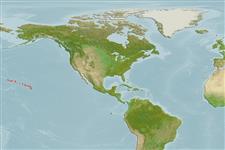Preferred temperature (Ref.
123201): 24.3 - 26.3, mean 25.1 °C (based on 60 cells).
Phylogenetic diversity index (Ref.
82804): PD
50 = 0.5000 [Uniqueness, from 0.5 = low to 2.0 = high].
Bayesian length-weight: a=0.00832 (0.00465 - 0.01489), b=3.01 (2.86 - 3.16), in cm total length, based on LWR estimates for this species & Genus-body shape (Ref.
93245).
Trophic level (Ref.
69278): 3.3 ±0.1 se; based on diet studies.
Resilience (Ref.
120179): High, minimum population doubling time less than 15 months (tm=1).
Fishing Vulnerability (Ref.
59153): Low vulnerability (18 of 100).
Nutrients (Ref.
124155): Calcium = 71.2 [43.3, 116.3] mg/100g; Iron = 0.751 [0.440, 1.322] mg/100g; Protein = 18.7 [15.8, 20.9] %; Omega3 = 0.145 [0.098, 0.222] g/100g; Selenium = 32.7 [20.8, 56.9] μg/100g; VitaminA = 71.8 [24.0, 258.1] μg/100g; Zinc = 1.46 [1.05, 2.27] mg/100g (wet weight);
